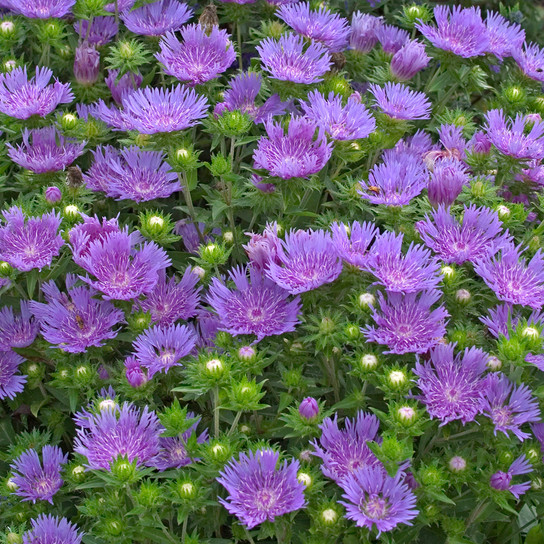
Asters
Uses:
- Borders
- Containers
- Mass Planting
Features:
- Attracts Pollinators
- Cut Flowers
- Late Blooming
Sunlight:
- Partial Sun to Full Sun
- At Least 5 Hours of Direct Sunlight
Growing Zones:
- 3-8
- What is My Zone?
Asters are beloved for their abundant, daisy-like flowers in shades of purple, pink, blue, and white, that bloom in late summer to fall. These perennials provide a burst of color when many other plants are fading. These are perfect for borders, cottage gardens, or wildlife areas where they can attract butterflies and other pollinators.
About Asters

Michaelmas Daisy, Fall Aster, Autumn Aster
North America (particularly the eastern and central United States, but also found in parts of Europe and Asia)
Perennials
Deciduous
3 - 8
Purple, pink, white, red, blue
Late summer to fall
Upright, bushy growth, typically reaching 2 to 6 feet in height depending on the species. Can spread and form clumps.
Pollinators such as bees, butterflies, and moths. Asters are often a late-season nectar source for these insects.
Drought, poor soil conditions, and full sun exposure. They can tolerate light shade but perform best with full sunlight.
Deer and rabbits tend to avoid asters, though not always.
How To Use Asters In The Garden
Asters are perennial plants known for their star-shaped flowers, which bloom from late summer to fall. They are native to various regions, including North America, and are appreciated for their ability to attract pollinators such as butterflies and bees. The flowers come in a range of colors, including purple, pink, blue, and white, adding bright hues to gardens during the autumn months. Additionally, certain parts of the aster plant have been used in traditional medicine practices.
Asters are commonly used in beds, borders, and mass plantings to provide late-season color. Their varying heights and growth habits make them suitable for different landscape designs, from ground covers to background plants. Moreover, asters are relatively low-maintenance, making them a popular choice among gardeners looking to extend the blooming season into the cooler months.
Types of Aster
| Type | Scientific Name | Native Range | Flower | Zones | Uses | Features |
|---|---|---|---|---|---|---|
| New England Aster | Symphyotrichum novae-angliae | E. & C. North America (moist prairies, streams) | 1½″ daisies; deep pink-purple rays, yellow disks | 4–8 | Meadows, rain & butterfly gardens, cut flower | Showy fall color, monarch nectar, clay-soil tolerant |
| New York Aster | Symphyotrichum novi-belgii | E. North America (coastal marshes, meadows) | 1–1¼″ rays violet-blue/ pink-white | 4–8 | Borders, rain gardens, naturalizing | Long bloom, wet- & clay-soil tolerant, butterfly magnet |
| Smooth Aster | Symphyotrichum laeve | N. America prairies & glades | ¾–1¼″ violet-purple rays | 3–8 | Prairie & roadside mixes, pollinator beds | Drought & rocky-soil tough; late nectar |
| Aromatic Aster | Symphyotrichum oblongifolium | NE & C. U.S. glades, prairies | 1″ violet-blue rays | 3–8 | Ground-cover masses, xeriscapes | Balsam-scented leaves; drought, clay & erosion tolerant |
| White Wood Aster | Eurybia divaricata | E. North America dry woods | 1″ white rays, yellow→red disks | 3–8 | Shade, woodland & cottage gardens | Blooms in deep shade; drought & rocky-soil tolerant |
| Blue Wood / Heart-Leaved Aster | Symphyotrichum cordifolium | E.–C. North America woods | ¾″ pale- to rich-blue rays | 3–8 | Naturalizing, open shade, butterfly beds | Thrives in dry/part shade; prolific seed for wildlife |
| Heath Aster | Symphyotrichum ericoides | C. & E. U.S./Canada prairies | ½″ white rays, yellow disks | 3–10 | Rock & drought gardens, prairie restorations | Dense “blizzard” bloom; drought, clay & poor-soil hardy |
| Bushy Aster | Symphyotrichum dumosum | Coastal plain & GL Lakes | ½–¾″ pale blue/ lavender-white | 4–9 | Meadow edges, sandy soils, wildlife plots | Airy sprays for late color; butterfly friendly; sandy-soil adept |
| Stokes’ Aster | Stokesia laevis | SE U.S. wetlands & pinelands | 2½″ cornflower-blue, frilly heads | 5–9 | Front borders, pond margins, cut-flower beds | Evergreen foliage, rabbit & drought resistant, moist-soil tolerant |
Asters Care
Asters appreciate well-drained soil with a slightly acidic to neutral pH. They require full sun exposure to bloom robustly. Provide approximately one inch of water per week and allow the top few inches of soil to dry out between waterings. While asters are not heavy feeders, incorporating compost or a balanced, slow-release fertilizer into the soil during planting can support healthy growth.
In early summer, pinch back the stems by one-third to increase the number of blooms in late summer and fall. After the first hard frost, cut back the stems to a few inches above the soil line to prepare the plant for winter. Applying a light layer of mulch, such as straw or compost, over the plant crowns can offer additional protection during colder months. For container-grown asters, select pots with adequate drainage holes and use a well-draining potting mix.
Learn More About Aster Care

Asters Companion Plants
Choose partners that thrive in six-plus hours of sun, drain quickly after rain, and accept only moderate watering—the same conditions asters need to flower freely. Boxwood gives an evergreen backbone and lets the daisy heads pop, while upright ornamental grasses echo the stems’ height and add late-season motion and seed-head interest. Spring-blooming lupine enriches the soil and steps back just as asters take the stage, and sprawling geraniums weave a weed-suppressing carpet that supplies color from thaw to frost without stealing light.

































